船舶动态定位系统简介
- 格式:doc
- 大小:4.02 MB
- 文档页数:68
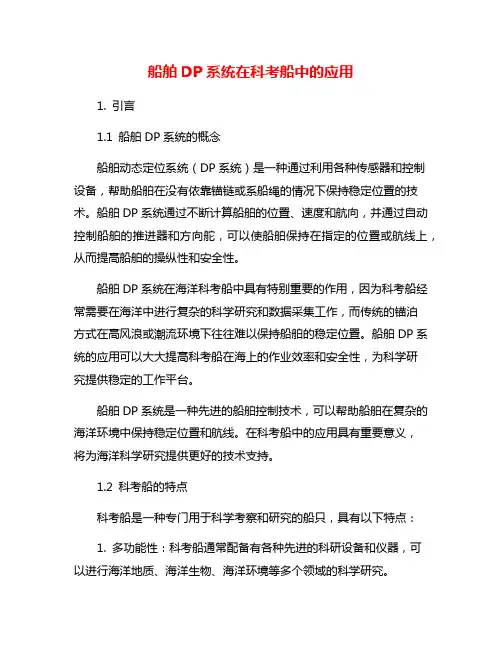
船舶DP系统在科考船中的应用1. 引言1.1 船舶DP系统的概念船舶动态定位系统(DP系统)是一种通过利用各种传感器和控制设备,帮助船舶在没有依靠锚链或系船绳的情况下保持稳定位置的技术。
船舶DP系统通过不断计算船舶的位置、速度和航向,并通过自动控制船舶的推进器和方向舵,可以使船舶保持在指定的位置或航线上,从而提高船舶的操纵性和安全性。
船舶DP系统在海洋科考船中具有特别重要的作用,因为科考船经常需要在海洋中进行复杂的科学研究和数据采集工作,而传统的锚泊方式在高风浪或潮流环境下往往难以保持船舶的稳定位置。
船舶DP系统的应用可以大大提高科考船在海上的作业效率和安全性,为科学研究提供稳定的工作平台。
船舶DP系统是一种先进的船舶控制技术,可以帮助船舶在复杂的海洋环境中保持稳定位置和航线。
在科考船中的应用具有重要意义,将为海洋科学研究提供更好的技术支持。
1.2 科考船的特点科考船是一种专门用于科学考察和研究的船只,具有以下特点:1. 多功能性:科考船通常配备有各种先进的科研设备和仪器,可以进行海洋地质、海洋生物、海洋环境等多个领域的科学研究。
2. 船龄较长:由于科考船的建造和改装需要耗费较多时间和资金,因此科考船的船龄通常较长,但在使用过程中会定期进行维护和更新。
3. 船员素质高:科考船的船员通常是经过专门培训和筛选的专业人员,具有丰富的科考经验和专业知识,能够应对各种复杂的海洋环境和情况。
4. 航行路线复杂:科考船通常需要在各种海洋环境中进行考察和研究,航行路线较为复杂,需要具备较高的航行技术和安全保障能力。
5. 船舶DP系统的重要性:在科考船的航行和科学考察过程中,船舶DP系统起着至关重要的作用,能够提高船舶的精确操控能力和安全性,确保船只能够在复杂的海洋环境中顺利进行科学考察和研究工作。
科考船的特点决定了船舶DP系统在其中的必要性和重要性。
2. 正文2.1 船舶DP系统在科考船中的必要性科考船在执行科学研究任务时,通常需要在海上停留一段时间进行数据采集和实验。
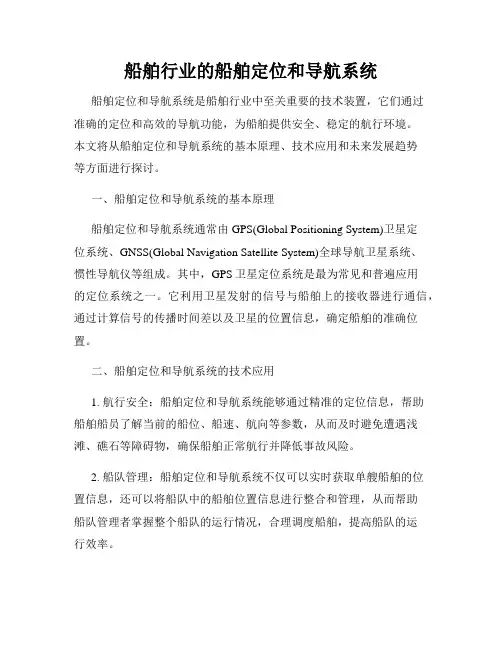
船舶行业的船舶定位和导航系统船舶定位和导航系统是船舶行业中至关重要的技术装置,它们通过准确的定位和高效的导航功能,为船舶提供安全、稳定的航行环境。
本文将从船舶定位和导航系统的基本原理、技术应用和未来发展趋势等方面进行探讨。
一、船舶定位和导航系统的基本原理船舶定位和导航系统通常由GPS(Global Positioning System)卫星定位系统、GNSS(Global Navigation Satellite System)全球导航卫星系统、惯性导航仪等组成。
其中,GPS卫星定位系统是最为常见和普遍应用的定位系统之一。
它利用卫星发射的信号与船舶上的接收器进行通信,通过计算信号的传播时间差以及卫星的位置信息,确定船舶的准确位置。
二、船舶定位和导航系统的技术应用1. 航行安全:船舶定位和导航系统能够通过精准的定位信息,帮助船舶船员了解当前的船位、船速、航向等参数,从而及时避免遭遇浅滩、礁石等障碍物,确保船舶正常航行并降低事故风险。
2. 船队管理:船舶定位和导航系统不仅可以实时获取单艘船舶的位置信息,还可以将船队中的船舶位置信息进行整合和管理,从而帮助船队管理者掌握整个船队的运行情况,合理调度船舶,提高船队的运行效率。
3. 航线规划:船舶定位和导航系统能够根据预设的航线,提供最佳的航行路径选择。
系统通过综合考虑船舶的当前位置、目的地、环境因素等,并结合导航图纸,为船舶提供航线规划,实现最短航程、最安全的航行路径。
4. 环境监测:船舶定位和导航系统还可以配合其他设备,对海洋环境进行实时监测和分析。
例如,利用系统中的气象传感器、海洋生物传感器等,可以获取并分析当前海洋气象、潮汐、水文等信息,提前预知海洋环境变化,为船舶航行提供准确的环境保障。
三、船舶定位和导航系统的发展趋势随着科技的不断进步和船舶行业的发展需求,船舶定位和导航系统正朝着以下方面发展:1. 卫星定位精度提升:通过增加卫星数量、提高接收器灵敏度等手段,提高卫星定位系统的定位精度,增加船舶位置信息的准确性,提高航行安全性。
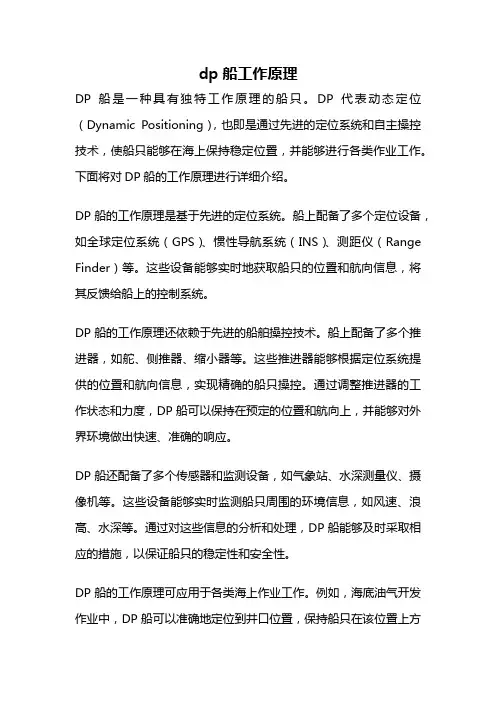
dp船工作原理DP船是一种具有独特工作原理的船只。
DP代表动态定位(Dynamic Positioning),也即是通过先进的定位系统和自主操控技术,使船只能够在海上保持稳定位置,并能够进行各类作业工作。
下面将对DP船的工作原理进行详细介绍。
DP船的工作原理是基于先进的定位系统。
船上配备了多个定位设备,如全球定位系统(GPS)、惯性导航系统(INS)、测距仪(Range Finder)等。
这些设备能够实时地获取船只的位置和航向信息,将其反馈给船上的控制系统。
DP船的工作原理还依赖于先进的船舶操控技术。
船上配备了多个推进器,如舵、侧推器、缩小器等。
这些推进器能够根据定位系统提供的位置和航向信息,实现精确的船只操控。
通过调整推进器的工作状态和力度,DP船可以保持在预定的位置和航向上,并能够对外界环境做出快速、准确的响应。
DP船还配备了多个传感器和监测设备,如气象站、水深测量仪、摄像机等。
这些设备能够实时监测船只周围的环境信息,如风速、浪高、水深等。
通过对这些信息的分析和处理,DP船能够及时采取相应的措施,以保证船只的稳定性和安全性。
DP船的工作原理可应用于各类海上作业工作。
例如,海底油气开发作业中,DP船可以准确地定位到井口位置,保持船只在该位置上方的悬停状态,以便进行钻探和生产作业。
在海上风电场建设中,DP 船可以实现风机塔筒的精确定位和安装。
此外,DP船还可以用于海底管线敷设、海洋科学调查、海洋环境监测等各类海洋工程作业。
总结起来,DP船的工作原理是基于先进的定位系统和船舶操控技术。
通过定位系统获取船只的位置和航向信息,并通过船舶操控技术实现精确的船只操控。
配合传感器和监测设备,DP船能够实现在海上保持稳定位置,并能够进行各类作业工作。
DP船的工作原理的应用能够提高海上作业的效率和安全性,为海洋工程领域的发展做出重要贡献。
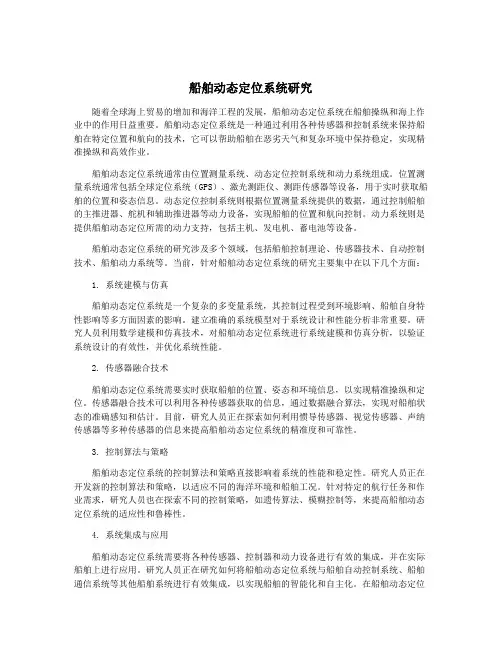
船舶动态定位系统研究随着全球海上贸易的增加和海洋工程的发展,船舶动态定位系统在船舶操纵和海上作业中的作用日益重要。
船舶动态定位系统是一种通过利用各种传感器和控制系统来保持船舶在特定位置和航向的技术,它可以帮助船舶在恶劣天气和复杂环境中保持稳定,实现精准操纵和高效作业。
船舶动态定位系统通常由位置测量系统、动态定位控制系统和动力系统组成。
位置测量系统通常包括全球定位系统(GPS)、激光测距仪、测距传感器等设备,用于实时获取船舶的位置和姿态信息。
动态定位控制系统则根据位置测量系统提供的数据,通过控制船舶的主推进器、舵机和辅助推进器等动力设备,实现船舶的位置和航向控制。
动力系统则是提供船舶动态定位所需的动力支持,包括主机、发电机、蓄电池等设备。
船舶动态定位系统的研究涉及多个领域,包括船舶控制理论、传感器技术、自动控制技术、船舶动力系统等。
当前,针对船舶动态定位系统的研究主要集中在以下几个方面:1. 系统建模与仿真船舶动态定位系统是一个复杂的多变量系统,其控制过程受到环境影响、船舶自身特性影响等多方面因素的影响。
建立准确的系统模型对于系统设计和性能分析非常重要。
研究人员利用数学建模和仿真技术,对船舶动态定位系统进行系统建模和仿真分析,以验证系统设计的有效性,并优化系统性能。
2. 传感器融合技术船舶动态定位系统需要实时获取船舶的位置、姿态和环境信息,以实现精准操纵和定位。
传感器融合技术可以利用各种传感器获取的信息,通过数据融合算法,实现对船舶状态的准确感知和估计。
目前,研究人员正在探索如何利用惯导传感器、视觉传感器、声纳传感器等多种传感器的信息来提高船舶动态定位系统的精准度和可靠性。
3. 控制算法与策略船舶动态定位系统的控制算法和策略直接影响着系统的性能和稳定性。
研究人员正在开发新的控制算法和策略,以适应不同的海洋环境和船舶工况。
针对特定的航行任务和作业需求,研究人员也在探索不同的控制策略,如遗传算法、模糊控制等,来提高船舶动态定位系统的适应性和鲁棒性。
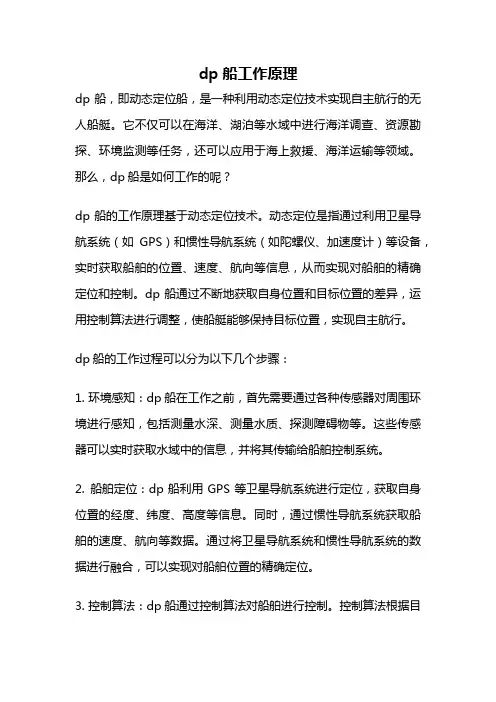
dp船工作原理dp船,即动态定位船,是一种利用动态定位技术实现自主航行的无人船艇。
它不仅可以在海洋、湖泊等水域中进行海洋调查、资源勘探、环境监测等任务,还可以应用于海上救援、海洋运输等领域。
那么,dp船是如何工作的呢?dp船的工作原理基于动态定位技术。
动态定位是指通过利用卫星导航系统(如GPS)和惯性导航系统(如陀螺仪、加速度计)等设备,实时获取船舶的位置、速度、航向等信息,从而实现对船舶的精确定位和控制。
dp船通过不断地获取自身位置和目标位置的差异,运用控制算法进行调整,使船艇能够保持目标位置,实现自主航行。
dp船的工作过程可以分为以下几个步骤:1. 环境感知:dp船在工作之前,首先需要通过各种传感器对周围环境进行感知,包括测量水深、测量水质、探测障碍物等。
这些传感器可以实时获取水域中的信息,并将其传输给船舶控制系统。
2. 船舶定位:dp船利用GPS等卫星导航系统进行定位,获取自身位置的经度、纬度、高度等信息。
同时,通过惯性导航系统获取船舶的速度、航向等数据。
通过将卫星导航系统和惯性导航系统的数据进行融合,可以实现对船舶位置的精确定位。
3. 控制算法:dp船通过控制算法对船舶进行控制。
控制算法根据目标位置和当前位置的差异,计算出船舶需要进行的调整动作,包括舵角调整、推进器功率调整等。
通过不断地计算和调整,dp船可以实现对目标位置的准确控制。
4. 自主导航:dp船在控制算法的指导下,实现自主导航。
它可以根据预设的任务要求,自主选择航线、避开障碍物,并根据实时的环境信息进行调整。
同时,dp船可以实现自主识别和跟踪目标,如海洋生物、沉船等。
5. 船舶安全:dp船在工作过程中,要保证船舶的安全性。
它可以通过与其他船舶进行通信,避免碰撞事故的发生。
同时,dp船还可以根据海洋环境的变化,及时调整航线和速度,确保船舶的稳定和安全。
dp船利用动态定位技术实现自主航行,具备环境感知、船舶定位、控制算法、自主导航和船舶安全等功能。
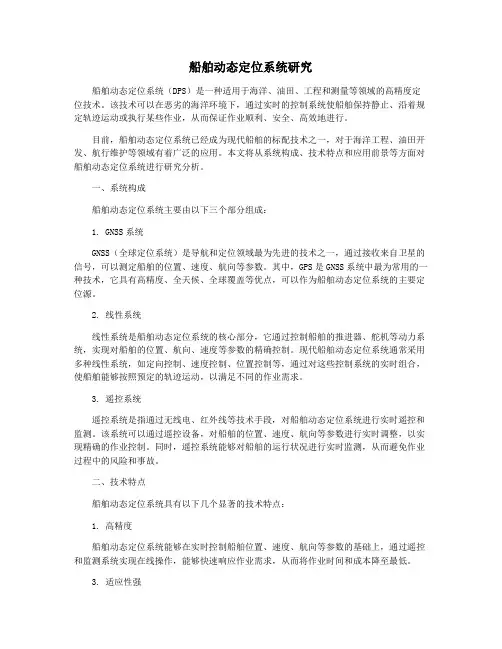
船舶动态定位系统研究船舶动态定位系统(DPS)是一种适用于海洋、油田、工程和测量等领域的高精度定位技术。
该技术可以在恶劣的海洋环境下,通过实时的控制系统使船舶保持静止、沿着规定轨迹运动或执行某些作业,从而保证作业顺利、安全、高效地进行。
目前,船舶动态定位系统已经成为现代船舶的标配技术之一,对于海洋工程、油田开发、航行维护等领域有着广泛的应用。
本文将从系统构成、技术特点和应用前景等方面对船舶动态定位系统进行研究分析。
一、系统构成船舶动态定位系统主要由以下三个部分组成:1. GNSS系统GNSS(全球定位系统)是导航和定位领域最为先进的技术之一,通过接收来自卫星的信号,可以测定船舶的位置、速度、航向等参数。
其中,GPS是GNSS系统中最为常用的一种技术,它具有高精度、全天候、全球覆盖等优点,可以作为船舶动态定位系统的主要定位源。
2. 线性系统线性系统是船舶动态定位系统的核心部分,它通过控制船舶的推进器、舵机等动力系统,实现对船舶的位置、航向、速度等参数的精确控制。
现代船舶动态定位系统通常采用多种线性系统,如定向控制、速度控制、位置控制等,通过对这些控制系统的实时组合,使船舶能够按照预定的轨迹运动,以满足不同的作业需求。
3. 遥控系统遥控系统是指通过无线电、红外线等技术手段,对船舶动态定位系统进行实时遥控和监测。
该系统可以通过遥控设备,对船舶的位置、速度、航向等参数进行实时调整,以实现精确的作业控制。
同时,遥控系统能够对船舶的运行状况进行实时监测,从而避免作业过程中的风险和事故。
二、技术特点船舶动态定位系统具有以下几个显著的技术特点:1. 高精度船舶动态定位系统能够在实时控制船舶位置、速度、航向等参数的基础上,通过遥控和监测系统实现在线操作,能够快速响应作业需求,从而将作业时间和成本降至最低。
3. 适应性强船舶动态定位系统具有很好的适应性,能够根据不同的作业需要,实现多种不同的控制方式,如动力定位、相对运动控制、静力定位等,满足海洋、测绘、勘探、工程等各种作业需求。
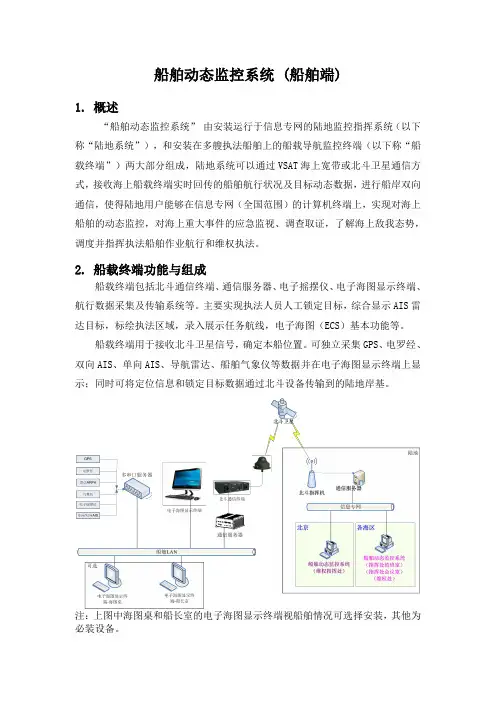
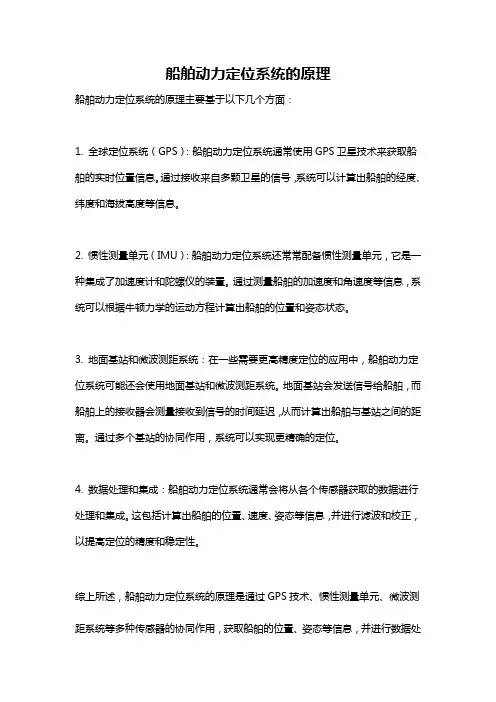
船舶动力定位系统的原理
船舶动力定位系统的原理主要基于以下几个方面:
1. 全球定位系统(GPS):船舶动力定位系统通常使用GPS卫星技术来获取船舶的实时位置信息。
通过接收来自多颗卫星的信号,系统可以计算出船舶的经度、纬度和海拔高度等信息。
2. 惯性测量单元(IMU):船舶动力定位系统还常常配备惯性测量单元,它是一种集成了加速度计和陀螺仪的装置。
通过测量船舶的加速度和角速度等信息,系统可以根据牛顿力学的运动方程计算出船舶的位置和姿态状态。
3. 地面基站和微波测距系统:在一些需要更高精度定位的应用中,船舶动力定位系统可能还会使用地面基站和微波测距系统。
地面基站会发送信号给船舶,而船舶上的接收器会测量接收到信号的时间延迟,从而计算出船舶与基站之间的距离。
通过多个基站的协同作用,系统可以实现更精确的定位。
4. 数据处理和集成:船舶动力定位系统通常会将从各个传感器获取的数据进行处理和集成。
这包括计算出船舶的位置、速度、姿态等信息,并进行滤波和校正,以提高定位的精度和稳定性。
综上所述,船舶动力定位系统的原理是通过GPS技术、惯性测量单元、微波测距系统等多种传感器的协同作用,获取船舶的位置、姿态等信息,并进行数据处
理和集成,从而实现对船舶动力的准确定位。
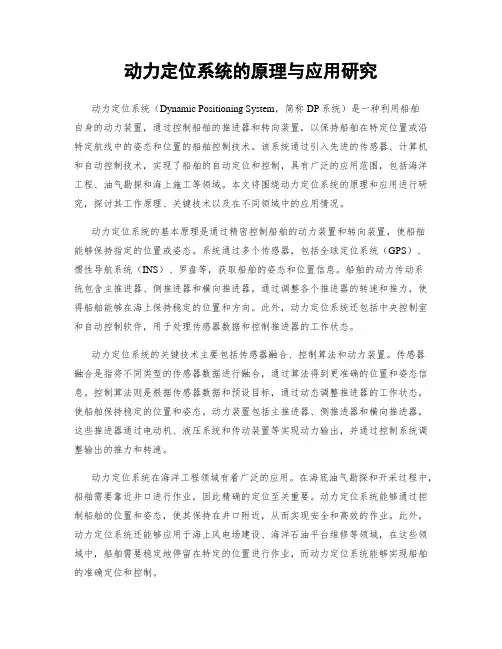
动力定位系统的原理与应用研究动力定位系统(Dynamic Positioning System,简称DP系统)是一种利用船舶自身的动力装置,通过控制船舶的推进器和转向装置,以保持船舶在特定位置或沿特定航线中的姿态和位置的船舶控制技术。
该系统通过引入先进的传感器、计算机和自动控制技术,实现了船舶的自动定位和控制,具有广泛的应用范围,包括海洋工程、油气勘探和海上施工等领域。
本文将围绕动力定位系统的原理和应用进行研究,探讨其工作原理、关键技术以及在不同领域中的应用情况。
动力定位系统的基本原理是通过精密控制船舶的动力装置和转向装置,使船舶能够保持指定的位置或姿态。
系统通过多个传感器,包括全球定位系统(GPS)、惯性导航系统(INS)、罗盘等,获取船舶的姿态和位置信息。
船舶的动力传动系统包含主推进器、侧推进器和横向推进器,通过调整各个推进器的转速和推力,使得船舶能够在海上保持稳定的位置和方向。
此外,动力定位系统还包括中央控制室和自动控制软件,用于处理传感器数据和控制推进器的工作状态。
动力定位系统的关键技术主要包括传感器融合、控制算法和动力装置。
传感器融合是指将不同类型的传感器数据进行融合,通过算法得到更准确的位置和姿态信息。
控制算法则是根据传感器数据和预设目标,通过动态调整推进器的工作状态,使船舶保持稳定的位置和姿态。
动力装置包括主推进器、侧推进器和横向推进器,这些推进器通过电动机、液压系统和传动装置等实现动力输出,并通过控制系统调整输出的推力和转速。
动力定位系统在海洋工程领域有着广泛的应用。
在海底油气勘探和开采过程中,船舶需要靠近井口进行作业,因此精确的定位至关重要。
动力定位系统能够通过控制船舶的位置和姿态,使其保持在井口附近,从而实现安全和高效的作业。
此外,动力定位系统还能够应用于海上风电场建设、海洋石油平台维修等领域,在这些领域中,船舶需要稳定地停留在特定的位置进行作业,而动力定位系统能够实现船舶的准确定位和控制。
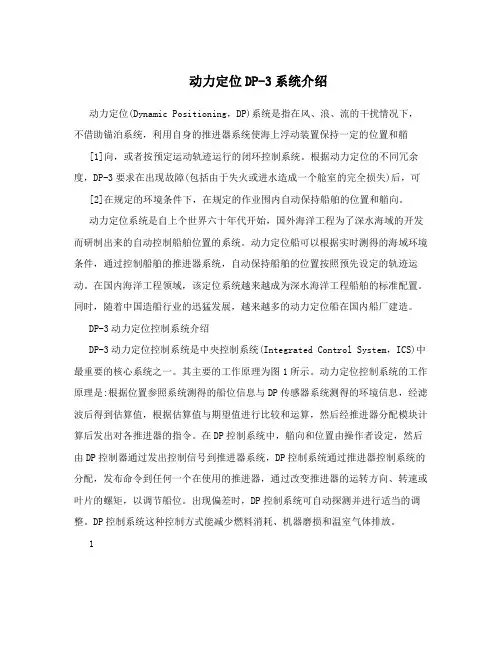
动力定位DP-3系统介绍动力定位(Dynamic Positioning,DP)系统是指在风、浪、流的干扰情况下,不借助锚泊系统,利用自身的推进器系统使海上浮动装置保持一定的位置和艏[1]向,或者按预定运动轨迹运行的闭环控制系统。
根据动力定位的不同冗余度,DP-3要求在出现故障(包括由于失火或进水造成一个舱室的完全损失)后,可[2]在规定的环境条件下,在规定的作业围内自动保持船舶的位置和艏向。
动力定位系统是自上个世界六十年代开始,国外海洋工程为了深水海域的开发而研制出来的自动控制船舶位置的系统。
动力定位船可以根据实时测得的海域环境条件,通过控制船舶的推进器系统,自动保持船舶的位置按照预先设定的轨迹运动。
在国内海洋工程领域,该定位系统越来越成为深水海洋工程船舶的标准配置。
同时,随着中国造船行业的迅猛发展,越来越多的动力定位船在国内船厂建造。
DP-3动力定位控制系统介绍DP-3动力定位控制系统是中央控制系统(Integrated Control System,ICS)中最重要的核心系统之一。
其主要的工作原理为图1所示。
动力定位控制系统的工作原理是:根据位置参照系统测得的船位信息与DP传感器系统测得的环境信息,经滤波后得到估算值,根据估算值与期望值进行比较和运算,然后经推进器分配模块计算后发出对各推进器的指令。
在DP控制系统中,艏向和位置由操作者设定,然后由DP控制器通过发出控制信号到推进器系统,DP控制系统通过推进器控制系统的分配,发布命令到任何一个在使用的推进器,通过改变推进器的运转方向、转速或叶片的螺矩,以调节船位。
出现偏差时,DP控制系统可自动探测并进行适当的调整。
DP控制系统这种控制方式能减少燃料消耗、机器磨损和温室气体排放。
1图1 DP控制系统工作原理动力定位系统是动力定位船的必要的完整装置,主要由电力系统、推进器系统和DP控制系统组成。
任何一个子系统发生故障都可能导致船舶失去定位或艏向保持能力。
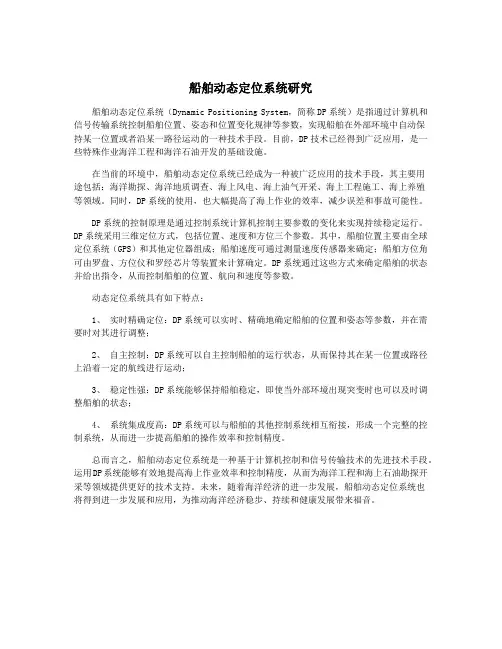
船舶动态定位系统研究船舶动态定位系统(Dynamic Positioning System,简称DP系统)是指通过计算机和信号传输系统控制船舶位置、姿态和位置变化规律等参数,实现船舶在外部环境中自动保持某一位置或者沿某一路径运动的一种技术手段。
目前,DP技术已经得到广泛应用,是一些特殊作业海洋工程和海洋石油开发的基础设施。
在当前的环境中,船舶动态定位系统已经成为一种被广泛应用的技术手段,其主要用途包括:海洋勘探、海洋地质调查、海上风电、海上油气开采、海上工程施工、海上养殖等领域。
同时,DP系统的使用,也大幅提高了海上作业的效率,减少误差和事故可能性。
DP系统的控制原理是通过控制系统计算机控制主要参数的变化来实现持续稳定运行。
DP系统采用三维定位方式,包括位置、速度和方位三个参数。
其中,船舶位置主要由全球定位系统(GPS)和其他定位器组成;船舶速度可通过测量速度传感器来确定;船舶方位角可由罗盘、方位仪和罗经芯片等装置来计算确定。
DP系统通过这些方式来确定船舶的状态并给出指令,从而控制船舶的位置、航向和速度等参数。
动态定位系统具有如下特点:1、实时精确定位:DP系统可以实时、精确地确定船舶的位置和姿态等参数,并在需要时对其进行调整;2、自主控制:DP系统可以自主控制船舶的运行状态,从而保持其在某一位置或路径上沿着一定的航线进行运动;3、稳定性强:DP系统能够保持船舶稳定,即使当外部环境出现突变时也可以及时调整船舶的状态;4、系统集成度高:DP系统可以与船舶的其他控制系统相互衔接,形成一个完整的控制系统,从而进一步提高船舶的操作效率和控制精度。
总而言之,船舶动态定位系统是一种基于计算机控制和信号传输技术的先进技术手段。
运用DP系统能够有效地提高海上作业效率和控制精度,从而为海洋工程和海上石油勘探开采等领域提供更好的技术支持。
未来,随着海洋经济的进一步发展,船舶动态定位系统也将得到进一步发展和应用,为推动海洋经济稳步、持续和健康发展带来福音。
船舶动态定位系统设计与实现近年来,随着海洋经济的发展和航运业的蓬勃发展,船舶动态定位系统(Dynamic Positioning System,简称DPS)成为海上交通中不可或缺的技术装备。
船舶动态定位系统基于现代导航技术和自动控制原理,可以实现船舶在没有锚泊或靠岸时,通过自身动力维持在某一点位附近的稳定位置,具备广泛的应用前景。
船舶动态定位系统设计需要考虑多个方面的因素,包括船舶类型、船舶尺寸、船舶用途和环境条件等。
首先,系统设计需要根据船舶类型来确定最适合的动力装置和控制系统。
不同类型的船舶具有不同的动力需求和控制要求,如大型油轮需要强大的推进力和高度可靠的定位系统,而船舶于HROV则需要精准的动力和定位控制。
其次,设计中需要考虑船舶尺寸和船舶用途。
船舶尺寸会影响动力装置和定位控制系统的选择,如小型船舶可以选用电动驱动和小型推进器,而大型船舶则需要采用更为强大的柴油或涡轮推进器。
船舶用途会影响定位系统的精度要求,如海洋科学研究需要更高精度的定位系统,而货船的要求相对较低。
环境条件也是设计船舶动态定位系统时需要考虑的重要因素。
船舶在不同的海况下需要具备不同的动力和定位控制能力,如高风速、恶劣气象条件下的定位要求更高。
设计中需要充分考虑海洋环境特点,确定适合的动力装置和控制策略,确保系统在恶劣海况下的可靠性。
在实际设计中,船舶动态定位系统的核心是定位传感器和控制系统。
定位传感器主要用于获取船舶的位置和航向信息,并传递给控制系统进行分析和判断。
常用的定位传感器包括全球卫星导航系统(GNSS)、惯性导航系统(INS)和水声定位系统等。
控制系统接收传感器的数据,并通过自动控制算法对船舶动力装置进行控制,使船舶维持在目标位置附近。
在系统实现方面,船舶动态定位系统的可靠性和稳定性是关键考虑因素。
船舶行驶中存在各种不确定性因素,如海流、风向、波浪等,这些因素对船舶的运行和定位都具有一定的影响。
为了提高系统的可靠性和稳定性,需要在设计中采用冗余技术和故障检测与排除机制,确保系统能够在异常情况下正常工作。
船舶DP系统在科考船中的应用随着科技的不断发展,船舶的技术也在不断更新和改进。
船舶DP系统(动态定位系统)作为船舶技术中的一项重要发明,已经在科考船中得到了广泛的应用。
船舶DP系统可以帮助船舶在海洋科考中实现更加精准的定位和操作,提高科考工作的效率和安全性。
本文将针对船舶DP系统在科考船中的应用进行深入探讨,以期更好地了解和推广这一技术在海洋科考中的作用。
一、船舶DP系统的基本原理船舶DP系统是一种能够实现船舶定位和姿态控制的系统,通过使用电脑控制船舶的推进系统、舵机系统和锚泊系统,实现船舶在水下位置的定位和控制。
船舶DP系统的核心技术是利用多个推进器和传感器实时监测船舶在水下的位置、姿态和环境变化,并通过计算机系统进行数据处理和控制指令的下达,实现船舶的准确悬停、定位和移动。
船舶DP系统在实际应用中可以大大提高船舶的操纵性和安全性,特别适用于需要长时间悬停和精确定位的科考工作。
1. 提高科考效率科考船通常需要在海洋中进行长时间的观测和勘测工作,需要稳定地悬停在特定的海域,并且需要在不同的海洋环境中进行精确的位置调整。
船舶DP系统可以通过实时监测海洋环境和船舶位置,并且通过电脑系统实现自动控制船舶位置和姿态,提高了科考船在海洋中的操作效率。
科考人员可以更加专注于科考工作本身,而不必为船舶的操纵和定位而分心,大大提高了科考效率。
3. 提高科考精度科考船通常需要在海洋中进行各种数据采集和样本勘测工作,这些工作对船舶的定位精度和悬停稳定性有着很高的要求。
船舶DP系统可以帮助船舶实现毫米级的精准悬停和定位,有效地提高了科考工作的精度。
科考人员可以更加准确地获取海洋数据和样本,为科学研究提供更加可靠的数据支持。
三、船舶DP系统在科考船中的发展现状目前,随着船舶DP系统技术的不断成熟和应用范围的不断扩大,越来越多的科考船开始引入和应用船舶DP系统。
一些国际知名的科考船舶,如“科考一号”、“挑战者号”等,都配备了先进的船舶DP系统,为科考工作提供了强大的技术支持。
船舶动态定位系统简介Introduction to DP 1 - IntroductionDynamic positioning (DP) is a rapidly maturing technology, having been born of necessity as a result of the increasing demands of the rapidly expanding oil and gas exploration industry in the 1960s and early 1970s. Even now, when there exist over 1,000 DP-capable vessels, the majority of them are operationally related to the exploration or exploitation of oil and gas reserves.动态定位系统是一个快速成熟的技术。
是基于1960年代到70年代油气勘探工业的需求的基础上产生的。
目前已经有超过1000艘以上的动态定位的船舶,其中绝大部分都后油气勘探有关。
The demands of the offshore oil and gas industry have brought about a whole new set of requirements. Further to this, the more recent moves into deeper waters and harsh-environment locations, together with the requirement to consider more environmental-friendly methods, has brought about the great development in the area of Dynamic Positioning techniques and technology.油气工业的需求给我们带来了一个全新的需求。
DP系统(Dynamic positioning system)介绍一.定义挪威船级社、美国船级社、英国劳氏船级社对动力定位船的定义如下:仅靠自身推力器的作用能够保持位置和艏向(固定位置或者预定轨道)的船舶。
一般地,动力定位是指不用抛锚,而由船载计算机自动控制推进器来保持船舶或浮动平台位置的技术。
它使用精密、先进的仪器来测定船或平台因风、浪、流作用而发生的位移和方向变化,通过计算机等自动控制系统对信息进行实时处理、计算,并自动控制若干个不同方向的推进器的推力大小和力矩,使船舶或平台回复到原有位置。
随着动力定位技术的发展,动力定位的概念更加广泛,轨迹控制、跟踪控制等都属于动力定位范畴。
二.系统结构(1)控制系统由一台装有控制器即控制软件的计算机执行控制,控制整个定位过程。
控制软件的性能在很大程度上决定着整个系统的优劣。
同时计算机也作为人工控制台使用,提供人机交互工作的平台,便于操作员监控管理。
(2)位置参考测量系统和传感器系统位置参考系统负责测量出船舶或平台相对于某一参考点的位置和艏向。
传感器系统包括有用于测量风速的风传感器,用于测量速度、加速度等运动信息的传感器。
(3)动力系统动力系统的功能是为整个动力定位系统供电并负责电源的分配和管理。
(4)推力系统推力系统是动力定位系统的执行机构,接受控制系统发出的推力指令产生推力。
推力系统一般由多个推力器组成,以一定的布置形式安装在船体上不同位置广义上的推力系统还包括推力调节控制部件、转速反馈装置等部分。
应用于动力定位的推力器,除了一般船舶上的主推进器,常用的型式还有隧道式推力器、全方位推力器及船体侧向推力器等。
隧道推力器是将螺旋桨安装在贯穿船体两侧的隧道中,隧道一般垂直于船体的中心平面,因此只能提供横向力,同时为获得更大的回转力矩,安装位置要尽量靠近艏尾两端。
全方位推力器是可以改变螺旋桨轴在水平面内方位的推力器,能够为定位提供任意方向上的推力,使用灵活方便。
船舶动态定位系统设计与实现船舶动态定位系统(Dynamic Positioning System,DPS)是一种通过计算机控制船舶位置和姿态的技术。
在复杂海况下,船舶可以通过DPS技术保持稳定的位置和姿态,从而保证海上作业的顺利进行。
本文将讨论船舶DPS系统的设计和实现。
系统架构首先,船舶DPS系统的架构主要包括传感器、控制器和推进器。
传感器主要包括GPS、测深仪、罗经等设备,用于获取船舶的位置、速度和航向等数据。
控制器则负责计算船舶的位置和姿态,并控制推进器实现对船舶的控制。
推进器包括舵和推进器,用于实现船舶的位置和姿态的控制。
系统设计DPS的系统设计首先需要确定控制算法,船舶动态定位控制通常采用反馈控制和自适应控制两部分。
其中反馈控制包括位置控制、速度控制和航向控制等。
自适应控制则包括适应滑移控制、适应干扰控制等。
在此基础上选择合适的控制器,通常采用模型预测控制、自适应PID控制等。
接下来需要确定传感器的类型和数量,船舶动态定位控制需要准确获取船舶的位置、速度和姿态等信息。
GPS、测深仪、罗经等设备可以作为传感器,但是在特殊情况下,如GPS信号干扰、水深不足等情况下,还需要其他的传感器补充。
最后是推进器的选择,推进器需要根据船舶类型和运行情况进行选择。
在指定电机功率时需要考虑到推进器的设计要求和动力学效率,同时还需要根据海况等确定防护措施和备用推进器安装等。
系统实现在系统实现过程中,需要通过软件控制和硬件控制两部分完成整个系统的运行。
首先需要设计控制算法并根据实际情况校正和优化算法。
在选择合适的控制器后,需要进行相关参数设置和调整。
然后需要编写程序实现算法和控制器的控制,在此过程中可以采用不同的语言,如C++、MATLAB等。
最后需要进行系统测试和验证,测试流程需要包括离线仿真测试、实时仿真测试、海上试验测试等环节。
在测试和验证过程中,需要记录相关数据和结果,并进行分析和总结。
总结本文介绍了船舶动态定位系统的设计和实现,包括系统架构、控制算法、传感器、推进器的选择和实现。
船舶动态定位系统研究
船舶动态定位系统(Vessel Dynamic Positioning System,简称DP系统)是一种用于船舶定位和维持位置的技术。
船舶动态定位系统通过引入先进的传感器和控制技术,能够使船只在无需锚泊或使用推进器的情况下,在海上保持稳定的位置。
船舶动态定位系统需要通过传感器获取船舶当前的位置和状态信息。
一般来说,这些传感器包括全球定位系统(GPS)、陀螺仪、加速度计等。
这些传感器能够实时测量船舶的位置、姿态、速度等参数,并将这些信息传输到控制系统。
船舶动态定位系统需要设计相应的控制算法,以实现对船舶位置的调节和维持。
这些控制算法一般基于船舶的动力学模型和环境数据,通过计算得到船舶需要采取的动作,如调整推进器的转速、方向等。
船舶动态定位系统还需要考虑海洋环境对船舶位置的影响。
海洋环境因素包括风、海流、浪高等,这些因素会对船舶的位置造成偏移。
船舶动态定位系统需要能够预测和补偿这些环境因素对船舶位置的影响,以保持船舶的稳定性。
船舶动态定位系统的研究还需要考虑系统的可靠性和安全性。
船舶动态定位系统是一项关键技术,任何系统故障或人为错误都可能导致严重的事故。
船舶动态定位系统需要具备高度的可靠性和安全性,包括备份系统、故障自诊断和纠正机制等。
船舶动态定位系统的研究是一项综合技术,涉及船舶测量技术、控制算法、环境预测等多个方面。
随着科技的不断进步和船舶运输的发展,船舶动态定位系统将在今后的船舶领域发挥越来越重要的作用。
船舶动态定位系统简介Introduction to DP1 - IntroductionDynamic positioning (DP) is a rapidly maturing technology, having been born of necessity as a result of the increasing demands of the rapidly expanding oil and gas exploration industry in the 1960s and early 1970s. Even now, when there exist over 1,000 DP-capable vessels, the majority of them are operationally related to the exploration or exploitation of oil and gas reserves.动态定位系统是一个快速成熟的技术。
是基于1960年代到70年代油气勘探工业的需求的基础上产生的。
目前已经有超过1000艘以上的动态定位的船舶,其中绝大部分都后油气勘探有关。
The demands of the offshore oil and gas industry have brought about a whole new set of requirements. Further to this, the more recent moves into deeper waters and harsh-environment locations, together with the requirement to consider more environmental-friendly methods, has brought about the great development in the area of Dynamic Positioning techniques and technology.油气工业的需求给我们带来了一个全新的需求。
不仅如此,随着油气工业向深海及更艰苦的区域发展,同时考虑到环保方式,这给动态定位系统在技术及工艺方面带来了巨大的发展。
The first vessel to fulfil the accepted definition of DP was the "Eureka", of 1961, designed and engineered by Howard Shatto. This vessel was fitted with an analogue control system of very basic type, interfaced with a taut wire reference. Equipped with steerable thrusters fore and aft in addition to her main propulsion, this vessel was of about 450 tons displacement and length 130 feet.第一条动态定位系统概念的船”Eureka”,建于1961年,由Howard Shatto设计和制造。
这条船安装着由非常简形式的模拟控制系统,配备有张力线做为参考。
在主推力系统之外,有配备了前后可操作的推进系统。
该船长130英尺,排水量约450吨。
By the late 1970s, DP had become a well established technique. In 1980 the number of DP capable vessels totalled about 65, while by 1985 the number had increased to about 150. Currently (2002) it stands at over 1,000 and is still expanding. It is interesting to note the diversity of vessel types and functions using DP, and the way that, during the past twenty years, this has encompassed many functions unrelated to the offshore oil and gas industries. A list of activities executed by DP vessels would include the following:到了70年代晚期,动态定位已经确立为一门技术。
到1980年,带DP功能的船舶就达到了65艘。
而到了1985年,这个数字就达到了150。
目前(2002),这个数字已经高达1000,而且还在迅速扩张。
很有趣的是,很多的船形都在使用DP技术。
而且,在过去的20年里,其中的很多功能已经不再局限于海洋工程油气工业。
下面的清单就是主要应用DP技术的船舶类型固定位置时,偶偶也用DP来辅助定位。
或用动态定位来减轻系泊绳的张力。
每个系统都有他们的优点和缺点。
Sketch 1.1 station keeping methodsDP Advantages: DP的优点▪Vessel is fully self-propelled; no tugs are required at any stage of the operation 船舶有自己的动力。
▪Setting-up on location is quick and easy 固定位置快而起容易▪Vessel is very manoeuvrable 船舶易于操纵▪Rapid response to weather changes is possible (weather vane) 可以快速应对气候变化▪Rapid response to changes in the requirements of the operation 可以快速应对操作变化▪Versatility within system (i.e. track-follow, ROV-follow and other specialist functions) 更多的操作功能▪Ability to work in any water depth 可以适应各种水深▪Can complete short tasks more quickly, thus more economically 快速完成小任务▪Avoidance of risk of damaging seabed hardware from mooring lines and anchors 避免海床上的硬损伤▪Avoidance of cross-mooring with other vessels or fixed platforms 避免和其他平台交叉锚泊绳缆▪Can move to new location rapidly (also avoid bad weather) 可以频繁的移到到新位置DP Disadvantages: DP的缺点▪High capital and operational expenditure 高投资和操作成本▪Can fail to keep position due to equipment failure 可能因为设备故障导致位置固定失败▪Higher day rates than comparable moored systems 和锚泊系统哦相比需要更高的租金▪Higher fuel consumption 消耗更多的燃料▪Thrusters are hazards for divers and ROVs 推进器对操作人员存在风险▪Can lose position in extreme weather or in shallow waters and strong tides极端气象和浅水或大潮时可能丢失位置▪Position control is active and relies on human operator (as well as equipment)位置控制与人的操作有关▪Requires more personnel to operate and maintain equipment 需要人员操作及设备维护From the above, it can be seen that DP will not always be the most economic solution. While vessels using moorings have a number of advantages, increasingly DP is the best option for many operations because the seabed is cluttered with pipelines and other hardware, so laying anchors has a high risk of damage to pipelines or wellheads. The option to moor to a platform rather than the seabed is also less frequent, because support vessels have become larger and platforms are not designed for the loads that can be placed in the mooring lines. Nevertheless, there is a risk that a DP vessel makes contact with a platform3.从上面可以看出,DP不总是最经济的方案。
虽然系泊仍然有很多优点,但随着海床上越来越多的管道及其他硬的物质,DP越来越成为一个更好的选项。
因为锚链可能会破坏管道或井口。
During the 1990s there was a rapid increase in the number of vessels with dynamic positioning systems. Many of these vessels have been designed for DP and integrated control of engines and thrusters, but there are also a large number of conversions and upgrades. The situation is market-driven and relies on operational efficiency which, in turn, places a high reliability requirement on equipment, operators and vessel managers.90年代以来。